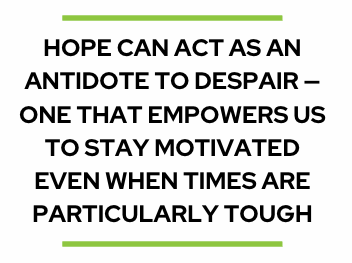Engineering Hope: Real Tools for Navigating Adversity
- Keith Hopper
- Mar 26
- 4 min read
Updated: Mar 27

Staying motivated and energized can be hard when it feels like the world is in crisis. Distress or adversity can diminish our energy and pull away our focus, yet this is the very time when we (and the world) most need our skills and attention. So what do we do?
One answer might lie in research done at Clemson University during COVID-19. The study examined musicians who were unable to perform during lockdown, and whether certain mindsets might make a difference with their struggles and engagement with work.
The researchers found that one mindset in particular - hope - not only successfully predicted professional engagement and resiliency and reduced distress, it directly contributed to better professional and personal outcomes. In other words, hope can act as an antidote to despair—one that empowers us to stay motivated even when times are particularly tough.

Hope as a motivator is a powerful idea. It’s not just that hope makes us feel better; it drives us to take action, even in the face of distress. Better yet, we know that hope is not a whimsical feeling, imparted on us by outside forces, but quite the opposite. Research shows that a sense of hope —defined by future-oriented thinking, goal-setting, and personal agency—can be fostered through specific, self-directed actions.
This means that when the outside world is bringing us down and making us feel hopeless, there is something we can actually do about it. We can create hope from despair, and this motivates us to act.
Before we dismiss hope as wishful thinking, it’s important to recognize the difference between hope and optimism. Optimism is expecting things will get better, while hope is believing that it’s possible—and understanding how to make it happen. This distinction highlights an important aspect of hope: its inherently proactive nature. Unlike optimism—which generally involves a passive expectation that things will improve—hope actively engages us by emphasizing personal agency, goal setting, and intentional action. Optimism might comfort us temporarily, but hope moves us to act purposefully despite adversity.
I recently experienced this as I sat down with a friend to talk about a distressing moment in her career. As a professional scientist, she had suddenly lost her research funding due to sweeping government cuts in NIH grants. What had driven her for 20 years to get up every morning had been taken away in an instant. Uncertainty about what was next was not only causing distress, it was sapping the very motivation needed to do something about it.

After some grieving, we walked through the three foundations of hope, and she constructed a path forward. First, we took an inventory of her strengths, connections, and resources still at her disposal. Asking, where might she look for answers, and what might she leverage to get a foothold?
Then, we explored possibilities for new directions, however small, that might be within reach - new areas for funding, new ways to leverage skills, and existing and untapped areas of her work and professional affiliations that had pleaded for attention in the past, like a Director role that she was already serving in, but was (yet) unsalaried.
Finally, we explored where each of these possibilities may lead, identifying the positive elements of these potential changes. Stepping away from day to day research could give time to pursue an emerging capability in public speaking, provide an excuse to explore new collaborations with respected colleagues, and pause some of the relentless bureaucracy of chasing government grants. From this came not just a glimmer of hope for the future, but some clear next steps that not only felt doable, but were driven by unique strengths and a positive vision. This motivated immediate action. She raced off - with no less uncertainty than before, but now with a sense of empowerment that only comes from seeing ourselves take control of our own circumstances.
What was clear from this experience was that a sense of hope was not only highly motivating, but achievable through practical, simple steps. While not difficult, this requires understanding the foundations of hope, knowing how to perform the research-backed reflections and activities that manufacture its elements, and a willingness to give it a shot.

One way to think about hope is like a tree. The roots are your skills, connections and resources — your grounded sense of self from where you draw power. The branches are the opportunities stretched out before you — your sense of possible futures. And the leaves are your near-term actions — the practical tasks linked to each opportunity that you alone can make happen. Each element of the tree stems from the other, and seeing them linked together helps us viscerally experience real possibilities for hope.
In the coming weeks, I will be exploring each of these foundational elements of hope to demonstrate how we can practically use them to foster hope in our work and lives.
I plan to share my investigations in a free newsletter series called "Engineering Hope." Each email will highlight my and others' real efforts trying out a different hope-based intervention, practical exercise, or guided tool to help us stay motivated, grounded, and future-focused—no matter what challenges we’re facing.
I’m looking forward to seeing where and how these activities will motivate my own work, and I’m deeply curious where pursuing hope in your own life and career may prove useful to you.
I look forward to exploring hope together.

Comentarios